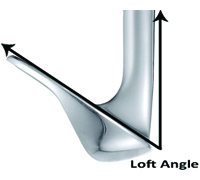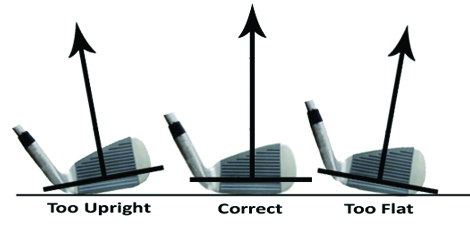
-

Shaft Length
Unless you get custom-fitted clubs, most clubs come in a set length for men or women, the main exception being the driver. Ideal shaft length for a driver is largely determined by ability level, height and personal preference. The shafts of most men’s drivers fall between 44.5” and 46”. Most male beginners of average height should be comfortable with a shaft in this range, although taller men may benefit from a slightly longer driver. Shaft lengths for women’s drivers tend to be about an inch shorter than men’s on average.
Shaft Flex
The flex of a club’s shaft is largely determined by the type of material (steel, titanium, graphite, hybrid, etc.), but also thickness and construction. The most common flex ratings for drivers are Extra Stiff, Stiff, Regular, Senior and Ladies. The chart below can be used to gauge ideal flex based on how far you can consistently drive the ball. Most beginners should look for a shaft with regular stiffness.
Ability Level Ideal Flex Rating Average Drive Distance Beginner to Intermediate Regular 225-250 yards Advanced Stiff 250-300 yards Expert Extra Stiff 300 yards or more Flex Point (Kick Point)
During each swing, a club’s shaft bends or “loads,” storing power, and subsequently releases that power as it strikes the ball. The shaft location that undergoes the most flex is called the flex point or kick point. Flex point placement affects trajectory.
Torque
In addition to flexing, the shaft of a golf club also twists slightly during a swing. The level of twist is called torque, and different materials have different ratings. In general, lower toque equates to greater control with a slight loss of power, and visa versa.
Loft
The angle of the striking surface of a club’s head (i.e. the clubface angle) determines loft. Loft is measured in degrees from vertical. Higher loft angle directly affects the trajectory or arc a ball will take after being struck (more loft equates to a higher arc). The profile image below shows the loft angle of a wedge.

Trajectory Rating
Although ball trajectory can be adjusted through loft and shaft type, many drivers also have a trajectory rating, usually expressed as HI (high), MID (medium) and LOW. If you have a slower swing and need help getting the ball airborne, look for a club with higher trajectory.
Lie
The “lie” of a golf club is the angle between the vertical center line of the clubface and the horizontal line created by the ground. The image below will give you a better idea of how lie can affect accuracy.

Forgivingness
Some clubs designed for beginners, often called game improvement clubs, incorporate features that give the club more “forgivingness,” including higher Moment of Inertia (MOI), a larger sweet spot and other elements that help compensate for off-center strikes.
-

So you’ve committed to learning how to play golf, and you’re ready to buy some clubs. Hold up! There are a few things you should consider before you buy. According to Golf Digest, when you’re just starting out, you don’t need to spend a small fortune on a new set of clubs. In fact, you don’t actually need a full set to start developing the fundamentals. Although players are allowed up to 14 clubs in their bag for sanctioned play, most players don’t need that many, especially beginners. A good starting point for most beginners includes a driver, 3 wood, 5 wood, 4 hybrid, 5 hybrid, irons 6 through 9, pitching wedge, sand wedge and putter.
The Driver
How much you spend on a driver is less important than choosing one that will work with your swing. There are four main considerations to bear in mind when choosing a driver: loft, trajectory rating, shaft length and flex (also flex point and torque, to a lesser extent). Most beginners have a slower swing speed, and will likely prefer drivers with 12 or more degrees of loft. Also look for a shaft with regular stiffness and a length between 45” and 46”. Beginners can also benefit from game-improvement drivers with more forgivingness.
Woods
Aside from the driver (sometimes called the 1 wood), woods provide the most distance, around 200-300 yards. Traditionally made of hardwoods, such as hickory, modern woods have large, heavy heads that are commonly made of steel or titanium.
Irons
Irons have metal heads, are numbered 1 through 9 and have more loft than woods, which makes them ideal for hitting the ball when it is closer to the green, usually 200 yards or less. Most beginners will only need irons 3 through 9. The 1 and 2 irons are by far the most difficult to master, and are not essential for recreational play.
Hybrids
To put it simply, a hybrid golf club (sometimes called a hybrid iron) is essentially a cross between a wood and an iron. Hybrids have a larger, heavier head than a traditional iron, but also have a different lie and flatter sole than a wood. This style of club is ideal for beginners and recreational players who commonly struggle with long irons (irons 1-3).
Wedges
Although they are technically considered irons, wedges are designed for specific tasks and have the most loft of all the clubs. Golf wedges are designed to hit shorter shots with a very high arc. A sand wedge is used to strike the ball from a bunker (sand trap). A pitching wedge is ideal for longer, arcing shots around 100-130 yards, and a lob wedge is used to clear obstacles with a short, high-arcing shot.
The Putter
Putting skills can have a significant impact on your overall game. Length and lie are the two key considerations when choosing a putter. The industry standard length for a traditional putter is typically 35”, which will serve as a good starting point for most beginners. However, golfing experts insist that players should get fitted for a putter as their skill level increases. There are two styles of putter heads:
- Blade heads are the most traditional style, and are best for more experienced golfers.
- Mallet heads are heavy with a large sweet spot, which makes them ideal for beginners.
Players who find a standard putter difficult to control may benefit from upgrading to either a belly putter or broomstick putter.
A note on golf balls
It’s important to know that not all golf balls are the same, although this is less important for beginners. Essentially, golf ball manufacturers produce several different varieties of golf ball. Some have additional interior layers to enhance spin and others have higher or lower compression ratings to complement different swing speeds. Since beginners tend to lose more balls, a less expensive set of balls should work just fine. As a golfer gains skill and lowers his handicap, he may consider investing in a higher-quality, specialized ball.
-

Since a round of golf typically involves spending several hours outside and a fair amount of walking, you’ll want to dress in comfortable, lightweight clothing. Golf clothing from brands like Fairway & Green, Callaway and Zero Restriction is always a great choice. Just be aware that some private courses and country clubs do enforce a dress code. The most common golf course dress code requires men to wear a collared shirt and will not allow jeans.
Golf Shirts
The classic polo shirt is a great option for golfing, and meets the collar requirement without being too formal. For hot and humid conditions, always choose a golf polo made of breathable, moisture-wicking fabric, rather than cotton. It’s also a good idea to have at least one long sleeve and one short sleeve golf shirt.
Golf Pants & Shorts
A comfortable, classic pair of khaki pants or khaki shorts makes an excellent option for golfers, and khakis are acceptable attire for most public and private courses. Many good-quality golf pants are crafted of breathable, wrinkle-resistant fabric and some even include a stain-resistant finish. Golf shorts range from classic navy blue to more casual plaids. Of course, if you really want to go old-school, you could opt for a pair of golf knickers!
Golf Jackets & Vests
The golf vest is a staple for days when you need a little extra core protection from the wind or chilly weather. A golf jacket is another must-have item for brisk, blustery conditions on the green. Modern golf jackets vary from superlight water-resistant shells to versatile soft shells. It’s a good idea to have a golf vest and jacket, so you can layer. Conditions can change dramatically over the course of a few hours, especially in the spring and fall.
Golf Gloves
Although not all golfers prefer to use golf gloves, this accessory can greatly enhance grip, especially during drives and longer shots that require a fast, powerful swing.
Golf Shoes
Golf shoes are an essential component of your golfing attire. Unlike regular athletic shoes, golf shoes feature specially designed cleats that provide enhanced traction on slick, grassy surfaces without damaging the terrain. Aside from providing traction as you walk the course, golf shoes also provide critical stability when swinging a club. Modern golf shoes from brands like Nike Golf, Geox and Etonic include support-enhancing features similar to other athletic shoes, and many also include replaceable cleats.
-

Before you venture onto a course for the first time, it’s important to be aware of a few safety and etiquette rules.
Golf Safety
According to the USGA, players should always make sure that no one is in the immediate flight path or landing area of the ball before making a shot. To warn people down the fairway or on the green that you are about to make a shot, the traditional word of warning is "fore." Also be sure no one is close enough to be struck by your club during a swing.
Pace & Player Consideration
If you or your group is playing at a slower pace than the group behind, it is courtesy to allow the group behind to play through and move on to the next hole. Players should show consideration toward other players regarding noise, especially during a shot. Try to avoid casting a shadow over another player’s line of sight during a putt.
Course Care
Always do your best to avoid damaging the terrain as much as possible. Repair divots in grass and smooth over holes in bunkers whenever possible. Remember to always properly replace the flagstick before leaving the putting green.
For a detailed list of golf etiquette guidelines, check out Golf Etiquette 101.